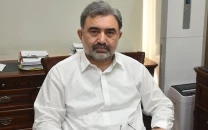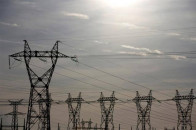Historically Sindh’s barrages have seen much worse: govt

At a press conference on Sunday, Irrigation Minister Jam Saifullah Dhareejo backed this argument with historical example as did the chief minister separately after a cabinet meeting.
Guddu Barrage has dealt with 1,300,000 cusecs and the Sukkur Barrage 1,100,000 cusecs in the past. Guddu Barrage is designed to handle about 1,200,000 cusecs and in 1976 a maximum of 1,100,000 cusecs was recorded. Kotri Barrage is designed to handle about 800,000 cusecs and it managed 900,000 cusecs in 1956.
Thus, Sindh’s officials are hoping that this infrastructure will be able to manage the estimated 900,000 cusecs expected in the next two to three days. By Sunday, 52,000 cusecs had entered Sindh.
Apres le deluge, snakes
After the province has survived the expected flood, it will have to face the snakes. According to the chief minister’s information aide, Jameel Soomro, snakebite occur very frequently after floods. The government has therefore decided to give the health department Rs25 million to arrange for vaccinations.
A meeting of the Sindh cabinet was held on Sunday to discuss the decisions taken at a special cabinet meeting on Saturday night.
The Sindh government expressed serious concern over the feeble condition of protective embankments on both sides of the River Indus. Cabinet members blamed a shortage of water and neglect by the previous government. According to irrigation officials, if water levels stay high in the rivers then the embankments stay strong. However, if the water flow increases suddenly after a long gap, then the embankments are at risk of breaches.
So, now you want to give us water
As the Sindh Cabinet discussed arrangements on how to tackle and be prepared for the flooding, a sense of irony prevailed. After all, just weeks earlier, the province was locked in a fight with the Indus River System Authority over its share of water.
This turn of events precipitated by the flooding was not lost on the southern province. CM Qaim Ali Shah quipped to the media that now the Punjab didn’t seem to mind sharing.
“All of this water, the Punjab will take as much as it wants to and will leave the rest for us. First they weren’t giving us any, from up-stream Kotri barrage. Now they say, pani janay, aap janain [it’s between you and the water]. So now, we will see. The Indus River is king. We can’t fight it, for sure. But we will try to limit it.”
Plugging the leaks
Protective bunds line 1,326 miles along the River Indus and the government has noted that 148 points are weak. As Sindh Minister for Irrigation Jam Saifullah Dharejo said, water is required to keep protective embankments strong. However, since 1976 the water levels have been so low that these bunds have been converted into animal shelters. Moreover, the embankments have eroded because people keep stealing mud from them and illegally constructing houses on the banks, which also weakens the ground.
The minister said that heavy machinery has been sent to vulnerable embankments so in case a breach develops, immediate action can be taken to plug the hole.
“Irrigation department officials have been deployed at every eight to 16 miles along the 145 points declared vulnerable,” he said.
The government does not have access to some areas in the katcha, which is the land surrounding the River Indus, because they are infested with bandits, said Dharejo, adding that police check posts have been set up every two kilometres along the protective embankments.
He also talked of residents in this area who have refused to evacuate. “The katcha (riverain) area runs along 1,200 miles. We appeal to people [there] to come out to the protective embankment if the government is unable to reach them,” he said.
By Sunday reports filtered in that 20 villages in Ghotki district have been inundated. Villagers said that no one had come to their rescue but DCO Ghotki Abdul Aziz Uqaily said that they had taken effective precautionary measures in the district. He said that despite the warnings, people in the katcha area were not willing to leave their homes.
When a participant at the cabinet session asked about setting up relief camps in schools, the minister replied that while some of the camps had been put up at schools most of them were actually along the embankments. Since residents of the katcha areas were most at risk, these camps are conveniently placed for them.
Otherwise shifting people from here to schools far away would be too much trouble. Meanwhile, those schools that are being used as makeshift camps will be shut down “for a while”.
He said that the district administration is busy relocating people to relief camps. District coordination officers (DCOs) and administrators are closely monitoring the situation 24 hours a day and giving updates to the flood centres established in district headquarters.
Unused funds, unkempt rivers
Officials in the irrigation department told The Express Tribune that although millions of rupees are allocated every year to maintain protective bunds, actual work has not been started.
“For the last seven years, work has only been started at Ghokti, Panoth (near Matiari) and Ghora Ghat while no work could be started at other places,” an official said.
Three major federally funded uplift projects to revamp irrigation infrastructure were included in the PSDP 2010, for which a hefty amount was also released during the outgoing fiscal year. But the provincial irrigation department has been accused of failing to use the funds appropriately.
Officials said that Rs500 million was released to continue work on the multi-year ‘Rs16.8 billion Revamping/Rehabilitation of Irrigation and Drainage Project’ for 2009-10. But only a fraction of it, Rs209 million, was used by May 2010.
In addition to this, Rs300 million was also released for a Rs13.8 billion project to line distributaries and minor canals in Sindh but the entire amount remained unspent.
For a third multi-year Rs2.5 billion Sukkur Barrage Rehabilitation and Improvement Project, Rs500 million was given to the government in 2009-10 but none of it was spent.
Published in The Express Tribune, August 2nd, 2010.



















COMMENTS
Comments are moderated and generally will be posted if they are on-topic and not abusive.
For more information, please see our Comments FAQ